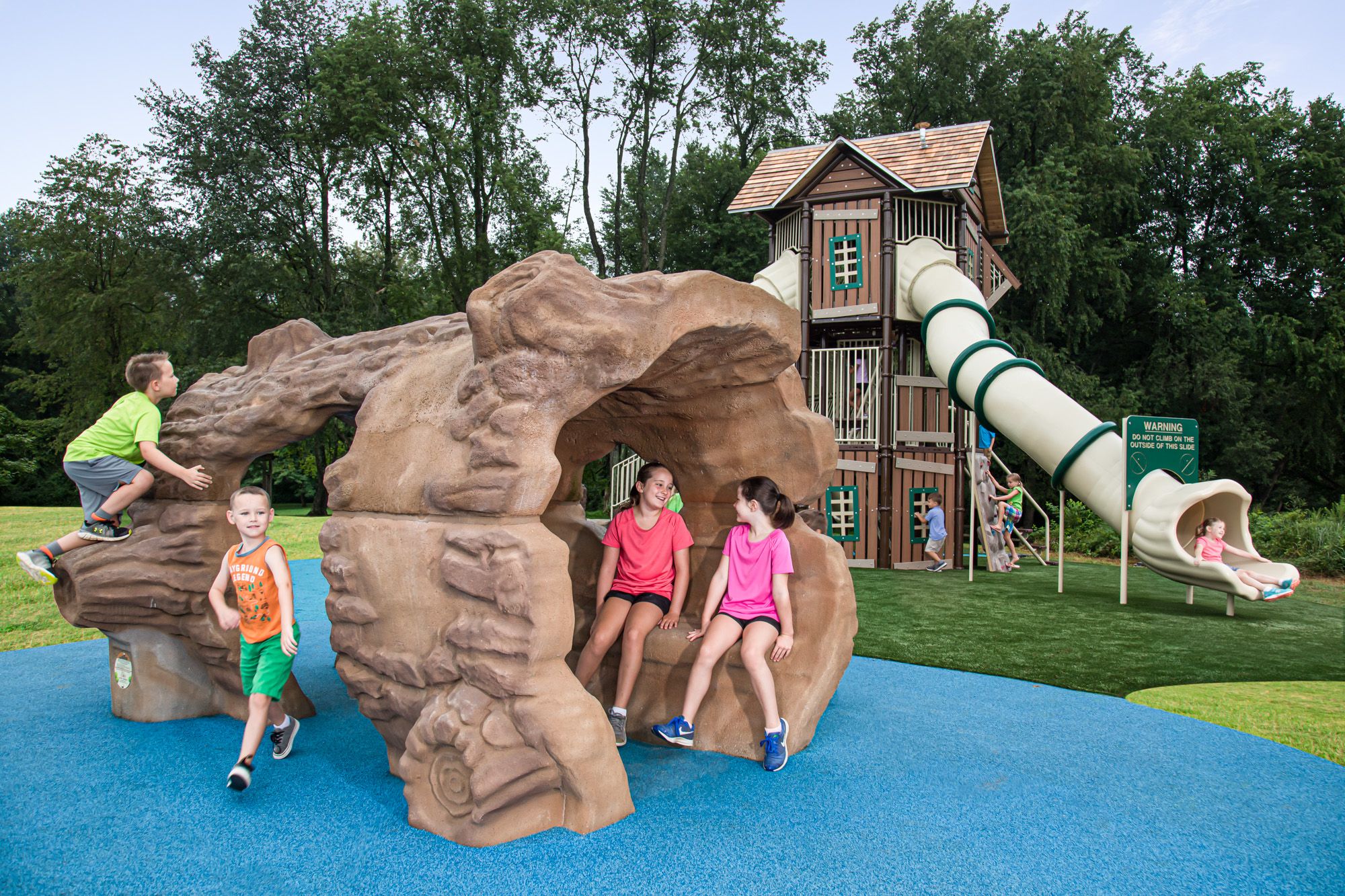Designing Natural Playgrounds: Bringing Nature to Play
Posted by May Recreation Content Team on

In recent years, there has been a growing trend toward incorporating natural elements into playground design.
While brightly colored play structures still have their place, there has been a movement to embrace the magic of nature, transforming playtime into an immersive experience that nourishes both body and mind.
Natural playgrounds aim to create an environment that encourages children to engage with nature while promoting imaginative play, exploration, and physical activity.
“Goodbye, big structures. Hello, dirt and sticks. Old-fashioned fun is back in style,” explained Texas Parks & Wildlife magazine. “A nature play revolution is sweeping the nation, and Texas is leading the charge.”
By bringing natural elements into playgrounds, designers can create spaces that are not only fun and challenging but also beneficial for children's development.
“We can create extraordinary places for children to discover themselves and the world around them,” designer Rusty Keeler wrote in Natural Playscapes, Creating Outdoor Play Environments for the Soul. “We can create places for children that tickle the imagination and surprise the senses. But first we have to remember the places and spaces of our own childhood.”
Benefits of Natural Playgrounds
Natural playgrounds aren't just a whimsical design trend; they offer a multitude of benefits for children's development:
- Unleashing Imagination: Unlike traditional playgrounds with predefined functions, natural elements like logs, rocks, and plants spark creativity. Children become architects, explorers, and storytellers as they transform these materials into spaceships, castles, or secret hideouts. This open-ended play fosters cognitive development and problem-solving skills.
- Boosting Physical Activity: Natural playgrounds are a fitness haven in disguise! Climbing structures, uneven terrain, and balancing elements encourage children to climb, jump, and navigate their surroundings, promoting gross motor skills and healthy physical development.
- Connecting with Nature: Natural playgrounds bridge the gap between urban environments and the natural world. By interacting with plants, rocks, and water features, children develop an appreciation for nature and a sense of environmental stewardship. This connection can inspire lifelong outdoor activities and a respect for the planet.
- Reducing Stress and Enhancing Wellbeing: Studies have shown that exposure to nature has a calming effect on children. Natural playgrounds, with their soothing sounds, textures, and sights, can reduce stress levels, improve mood, and even enhance cognitive function.
- Building Social Skills: Natural playgrounds encourage collaborative play. Children work together to build structures, navigate obstacles, and create imaginary worlds. This interaction fosters communication, teamwork, and social skills development.
Core Elements of Natural Playgrounds
The magic of natural playgrounds lies in their ability to transform simple elements into captivating experiences. Here are some key design features:
- Embankment Slides: Forget metal tubes! Natural slides built into slopes or hills offer a thrilling ride while seamlessly blending into the landscape. Imagine the exhilaration of whooshing down a grassy hill or a strategically sculpted sand dune!
- Climbing Challenges: Natural climbing structures like boulders, fallen logs, and rope ladders provide an opportunity for children of all abilities to test their strength, coordination, and risk-taking skills. These elements, carefully selected and arranged, create a safe and engaging climbing experience that fosters a sense of accomplishment.
- Jumping and Balancing Fun: Stumps, steppingstones, and strategically placed logs transformed into balance beams encourage children to develop jumping and balancing skills. These elements can be arranged in a variety of configurations, offering different levels of difficulty, and encouraging exploration.
- Swinging into Nature: Swings made from natural materials like rope and wood offer a classic play experience while harmonizing with the natural environment. Imagine soaring through the air on a sturdy rope swing, or gently swaying on a wooden swing nestled amidst trees.
- Water Play Wonders: Water features like streams, pumps, and sand areas ignite children's curiosity and encourage sensory play. Splashing, building sandcastles, and experimenting with water flow provides endless entertainment and opportunities for learning about cause-and-effect.
- Planting and Gardening Magic: Including gardens and planters in the playground design allows children to learn about plant growth cycles and engage in hands-on gardening activities. Planting vegetables, herbs, or native flowers adds a vibrant touch to the space and fosters a sense of responsibility for the environment.
- Loose Parts Playground: Incorporating loose parts, such as natural materials like sticks, stones, pinecones, and even recycled objects like buckets and tubes, allows children to create their own play experiences. This fosters creative thinking, problem-solving, and collaborative play.
Best Practices for Bringing Nature to Playgrounds
Creating a successful natural playground requires careful planning and attention to detail:
- Local is Beautiful: Sourcing materials native to the area adds a unique character to the playground and fosters a sense of place. Using local materials also reduces the environmental impact of construction and promotes sustainable practices.
- Safety First: While natural elements can be exciting, safety is paramount. Careful selection and placement of materials, along with proper cushioning and surfacing, are essential to ensure a safe play environment for children of all ages.
- Accessibility for All: Natural playgrounds should be inclusive and cater to children of all abilities. Consider wheelchair-accessible ramps, sensory elements for visually impaired children, and adaptable play structures to ensure everyone can enjoy the benefits of nature play.
- Shades of Fun: Shade is crucial for creating a comfortable play environment. Trees, strategically placed shade sails, or cleverly positioned structures can provide respite from the sun and allow children to enjoy the playground year-round. Consider using shade sails made from recycled materials to further enhance the playground's sustainability.
- Community Collaboration: Involving the community in the design and construction of a natural playground can foster a sense of ownership and pride. This can take the form of community fundraising events, design workshops with local parents and children, or volunteer days for building elements of the playground. Community involvement not only strengthens the connection to the space but also ensures it reflects the needs and desires of the local population.
- Long-Term Planning: Natural playgrounds are not static entities. They evolve over time as plants mature, wear and tear occur, and children's needs change. Therefore, long-term planning is essential. Establish a maintenance schedule that includes regular inspections, repairs as needed, and potential updates to the play elements to keep the space safe, engaging, and inspiring for future generations.
Natural playgrounds are more than just play spaces; they are immersive experiences that nurture children's physical, emotional, and cognitive development.
By incorporating nature into play, we create spaces that spark creativity, encourage exploration, and foster a lifelong connection with the natural world.
We may live in a digital-first world, but nature still plays an increasingly important role in our lives.
Natural playgrounds offer a respite from online activity, reminding us of the power of open-ended play and the magic that unfolds when children are free to explore the wonders of the natural world.
Reach out to May Recreation today in the greater Houston area to build your perfect playground.
